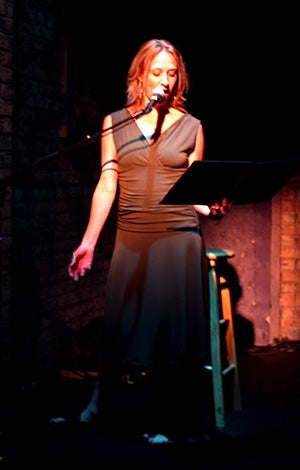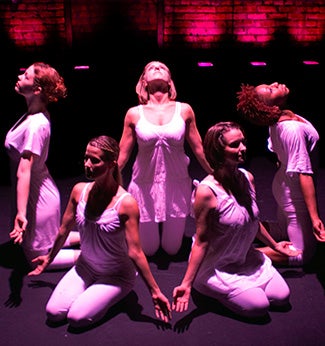David Emanuel
Reading Is (Not) Performance
The Red Rover Series {readings that play with reading}, founded in 2005 by fiction writer Amina Cain and poet Jennifer Karmin (curated by Karmin and Lisa Janssen of the journal MoonLit since late 2008), presented its 14th Experiment in July 2007 at Lifeline Theatre in the Rogers Park neighborhood of Chicago. The author featured for the evening was New York poet Kristin Prevallet. As is the case with all Red Rover Experiments, Prevallet collaborated with the curators of the series to create the event. Prevallet’s relationship with Karmin dates back to the early days of the Poetics Program at SUNY-Buffalo, where both were students. More than a decade after developing a relationship while involved with the co-operative press Leave Books at Buffalo, Prevallet and Karmin found themselves collaborating on an experiment for Red Rover.
Red Rover stands apart from other reading series in Chicago for a variety of reasons. It is a woman-oriented series run by women in a male dominated literary culture. This is not to say that it exclusively features female artists and writers. Karmin and Cain have brought new and exciting work to the public through their reading series by both female and male artists. The series itself had its genesis by way of a separate project Cain was involved with for the public art collective Anti Gravity Surprise, of which Karmin is a founding member. The Red Rover Series brings people from different parts of the creative community, both locally and globally, and puts them in contact with one another. Red Rover is more than a simple reading series. It attempts to foster an interdisciplinary community of artists presenting work to the public.
The series aims to experiment with the act of reading, and each experiment attempts to expand, redirect, and/or redefine writing. Approaching the reading as a language-based performance experiment with multiple collaborators demands that readers step away from the podium and allow their bodies as well as their words to fill the space. Other experiments have resulted in a reading where the audience moved from one reading “station” to another, while the readers remained stationary. Another Red Rover Experiment created a large-scale exquisite corpse, and others have incorporated installation as well as performance into the evening’s presentation. The best Red Rover Experiments happen when the artists involved approach ready not only to push the limits of what a reading is but also to collaborate with the curators in a situation where the work presented will be available to response, and that response in turn will form part of the performance, which is the reading (which, in the playful realm of Red Rover, is a sort of performance that is not really performance at all). In the case of Kristin Prevallet, the raked seating of the venue loaned the conventions of the theater to the evening’s performance.
Not a straightforward poetry reading and not simply dance, the work was a collaboration between Prevallet, her choreographer sister Elizabeth Schmitz, and the Red Rover Series. Created as a tribute to Prevallet and Schmitz’ father, who committed suicide in 2000, the work brought text and movement together in a poignant dialogue, ultimately expanding both the notion of language and movement.
The deliberate distance inserted between audience and performer served as a buffer between the audience and the very serious subject matter of the performance. Prevallet’s book, I, Afterlife: An Essay in Mourning Time published by Essay Press in 2007, provided the base text for the performance. This beautiful volume, made up of poetry, essay, eulogy and found texts, presents the way in which the author mourns the loss of her father, and illustrates how mourning can become a political act. Quite literally nothing is off limits to the audience--Prevallet includes pieces of the police report from the scene of the suicide, ephemera from her father’s life, and texts found during this period in her book.
Prevallet’s non-traditional essay, however, is only the starting point for this event. Prevallet’s sister, Elizabeth Schmitz, contributed half of the evening’s performance by way of her choreography. This was the first performance for Schmitz’ From the Hip Dance Project, presenting responses to selected portions of the text read by Prevallet. By combining reading and moving, Prevallet and Schmitz effectively create three texts: one composed of words, another of movement, and yet another somewhere between the two. In the midst of all this, literary notions collide and combine with performance practices, and literature fills space and time in a way not possible in the traditional reading.

Photograph by David Schmidt

Photograph by Joel Soto
This happens not all at once, but little by little over the course of the evening. Beginning in a reassuring manner, with Prevallet reading from a notebook at a podium, and continuing with the approach of the small troupe of dancers moving in response, movement slowly integrates itself into the fabric of the text. As the evening continues, Prevallet herself steps away from the podium to allow her body to interact with the others on stage as part of an homage to Cage’s 4’33” and to his compositional principles as well, no doubt.
Elizabeth Schmitz, still quite young as a choreographer, has yet to fully develop a wholly effective vocabulary of movement. Nonetheless, just as certain words used in certain sequences create resonances, so do certain gestures and movement sequences. By placing the two side by side, the work is allowed to fully inhabit the space of the stage. At its best, the choreography provided a response to the text the audience could receive and register. In these moments, the performance was effectively doubled, with the poem read first in words and then in movement. Movement sequences reminiscent of the trajectories of subatomic particles repeated themselves, in much the same way that fragments of text repeated themselves, forming an alternative viewpoint, one reminding the audience of the reality of the source materials.
It was the interaction between this very strong text and movement that made this Experiment so successful. Indeed, when Prevallet explains that the death of her father has left her “filled with holes,” the audience sees the dancers attempt to come together as one, only to fall back into their own spaces, illustrating the notion (fundamental to Prevallet’s text) that absence is part of existence. For a few moments on stage, poetry and performance became intertwined to the point that neither seemed to be dominant. Poetry expressed itself as a performance practice, and dance became literary.
While the Experiment would perhaps not have been as successful as a dance sequence alone, the trust that exists between Prevallet and Schmitz allowed the work to open itself to the collaborative process. Without trust, they would not have been able to allow Jennifer Karmin, as stated in her introduction to the Experiment, to “share silence” with them, their father and the audience. It is this trust that has allowed the Red Rover Series to reconsider the reading, allowing all parties involved to create something new and unexpected for the audience to consider.
Links Cited:
- Red Rover Series: http://groups.yahoo.com/group/redroverseries
- MoonLit: http://moonlitmag.blogspot.com
- Leave Books: http://wings.buffalo.edu/epc/presses/leave.html
- Anti Gravity Surprise: http://www.antigravitysurprise.org
- From the Hip Dance Project: http://www.fromthehip.org
Bio:
David Emanuel creates text and text-based pieces. He has collaborated with artists to make performance installations, zines and occasional artifacts. Outside of these creative practices, he writes about performance and is the Business Manager for the performance space Links Hall in Chicago, IL. http://www.linkshall.org.